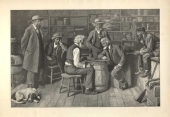The Checker Maven
The World's Most Widely Read Checkers and Draughts Publication
Bob Newell, Editor-in-Chief
Published every Saturday morning in Honolulu, Hawai`i
Noticing missing images? An explanation is here.
From Corner to Corner

From one corner to the other, boxers chase their opponents, hoping to land the winning blow. The fighter above seems ready to come out of her corner and do whatever it takes to lay out her opponent.
But some fighters win by decision rather than the quick knockout. That fact, and the title of today's column, provide broad hints toward the solution of the problem shown below.
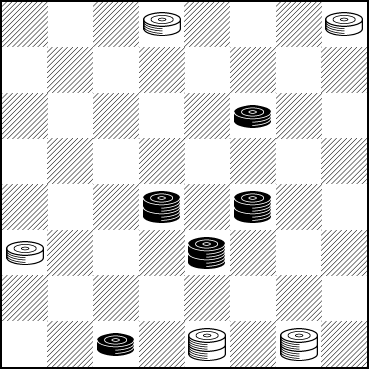
BLACK
Black to Play and Win
B:W31,29,12,K2,K1:B22,K15,K14,K10,3.
Before you begin, let's make note of a couple of things. First, White has two kings more or less entrapped in or near the Black double corner. Second, White has a man on 12 that is immobilized. Finally, White holds a bridge position on 29 and 31, but the man on 29 is immobile, and if White moves the man on 31, Black can stop it with 15-19 and then win it a few moves later.
So what can White do? Not much except perhaps shuffle around in the double corner. Black has a tremendous mobility advantage. That usually spells a win. The question is how to make it happen.
We'll repeat our hints. This is not a quick knockout; to win, Black must patiently apply technique. And again, keep in mind the title of our study. It's by no means an easy fight. This one is championship class.
Don't let this one knock you out; win the decision, then land your mouse on Read More to check your solution.![]()
London Bridge

One of Great Britain's most famous landmarks, London Bridge, has changed a lot over the years. The sketch above depicts London Bridge as it supposedly looked near the end of the 17th century. It's a far cry from today's London Bridge, and we suspect that's just as well.
One thing that hasn't changed over the years, though, is the Bridge Position in our game of checkers. Certainly, more variations and interesting problems have been published, but at heart a bridge has the same fundamental characteristics as ever.
Of course, sometimes a bridge is a win, sometimes a loss, and oft-times a draw. It all depends. In the following position, a rather unornamented bridge turns out to be a loss for the bridging side.
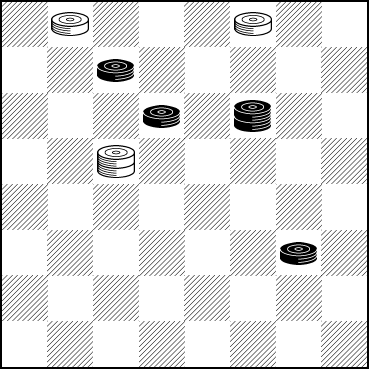
BLACK
Black to Play and Win
B:W32,30,K19:B27,23,K22,9.
Is this a bridge that you can cross, by finding the Black win? We'd rate the difficulty as medium; if you're familiar with bridges, you won't have any trouble with it; and if you're not familiar with these positions, this is a good time to bridge that gap. When you're ready, click on Read More to see the solution.![]()
At A Stroke

We didn't think they could do it, but our intrepid Research Department managed to come up with another meaning for the word stroke, to wit: at a stroke, with the meaning of "all at once," such as, "we solved a dozen checker problems at a stroke."
That would be quite a feat, indeed, and of course you just know we're going to present a stroke problem to kick off the month of June.
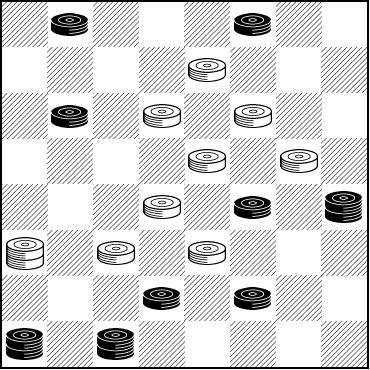
WHITE
White to Play and Win
W:W23,22,K21,18,16,15,11,10,7:BK30,K29,27,26,K20,19,9,3,1.
Can you solve this one "at a stroke" or will it take you longer? Are your powers of visualization up to the challenge? If you find the position difficult, we refer you to the quote at the beginning of the article.
When you've determined the correct moves, clicking on Read More will bring you to the solution--- at a stroke.![]()
The Outdoor Life

Spring is coming around in the Northern Hemisphere and perhaps, if you've had a long winter, you're thinking about re-engaging in the outdoor life. There's much to do in the great outdoors and every reason to take full advantage.

While today there's a commercial magazine called Outdoor Life, almost a hundred years ago there was another called The Journal of the Outdoor Life, published by the National Tuberculosis Association. We found it to be quite an interesting general readership journal, promoting the idea that fresh air is good for tuberculosis patients. Of course, medicine has advanced enormously in the last hundred years and some of the ideas in the Journal definitely seem quaint.
Interestingly, the Journal also had a "Games and Indoor Sports" section which contained some excellent checker material. Featuring checkers was fairly common back in that day, but alas, that is no longer the case.
In 1920 The Journal of the Outdoor Life published the following doozy.
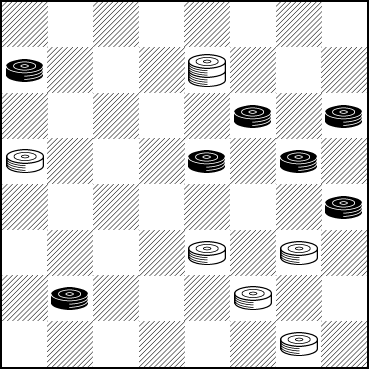
WHITE
White to Play and Draw
W:W32,27,24,23,13,K7:BK29,25,20,16,15,12,11,5.
Unless you have a sharp pictorial memory, this is not one to solve on an outdoor hike or while sitting around the campfire. Do it at home, after your outdoor activities are over for the day or weekend. You'll definitely need to concentrate and employ your powers of visualization, although the problem is certainly no more difficult than the "medium" category.
When you've finished, camp out on Read More to verify your solution.![]()
A (Not So) Easy Problem

On the first Saturday of the month we often have a speed problem, an easy problem, or a stroke problem. Today we have a (not so) easy problem.
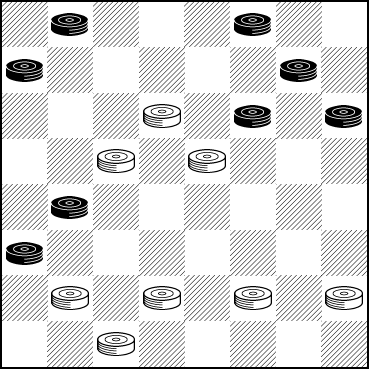
WHITE
White to Play and Win
W:W30,28,27,26,25,15,14,10:B21,17,12,11,8,5,3,1.
This one in a way is in two parts. There's the easy part in the beginning, and chances are you'll see that right away, even though White is on the verge of losing a piece. But then there's the second part. You'll see what we mean when you work on solving it. In any event, this little study is a great demonstration of an important winning technique.
Will you find a winning way easily or (not so) easily? This week, we suggest you take as much time as you need, and then click on Read More to see the solution and explanatory notes.![]()
Canadian Checker Class

Professor W. R. Fraser was a Canadian champion who also published books and studies on checkers, mostly notably The Inferno of Checkers, in which he used Dante's Inferno as a metaphor. We won't delve further into that interesting literary area today; instead we'll emphasize Prof. Fraser's academic side, by presenting one of his studies from a group Tom Wiswell included in a small collection that Mr. Wiswell called Canadian Checker Class.
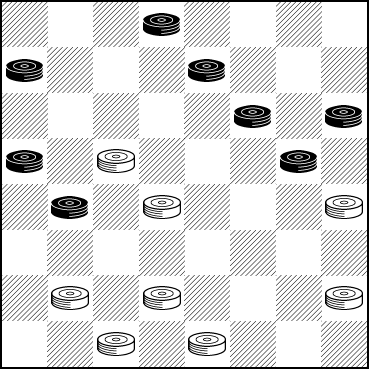
WHITE
White to Play and Win
W:W31,30,28,26,25,20,18,14:B17,16,13,12,11,7,5,2.
We'd rate this one as fairly hard, though short of infernal. If you get the first move right and figure out the theme, you'll be able to solve it. Treat this as a professorial homework assignment rather than a descent into Hades, and see if you can get it, then burn your mouse on Read More to see the solution.![]()
The Tax Man
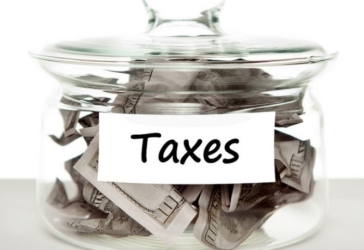
This column appears on April 15, 2017. April 15, in the United States, is the infamous day on which income tax returns are due, along with any money you might still owe. Checker Maven staff get hit pretty hard every year; we certainly hope that you do better, regardless what country you call home.
We have a slight reprieve, as when April 15 falls on a weekend, we're ever so generously allowed until Monday to pay up. So, let's enjoy a checker problem before we face the music two days hence.
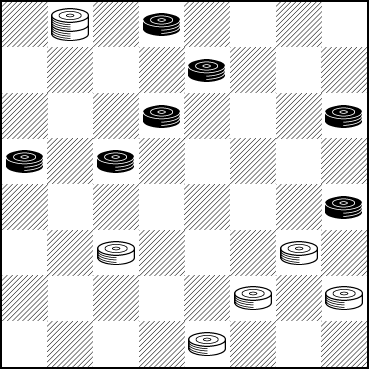
WHITE
White to Play and Draw
W:W31,28,27,24,22,K1:B20,14,13,12,10,7,2.
White is a piece down and it's not looking so good. Would you say it's kind of like the way the tax man hits us with a big bill when we can least afford it? But in this case, White can beat the tax man and break even (try to do that with the IRS)--- no cheating required.
Tax your brain instead of your wallet. The solution is elegant and pleasing, if every bit as hard to find as enough cash to pay that tax bill. See how you do, then file your return by clicking your mouse on Read More to get your refund--- or if not exactly a refund, a look at the solution and some explanatory notes.![]()
Without

The picture above dates to World War II, when many did without in support of the war effort. Luckily, today, in the free world we generally don't have to do without, as a minimum, the basic necessities.
In checkers, there is "doing without" as well; in today's study, the winning side has to make do without "the move." This is called in textbooks, logically enough, "first position without."
We know that first position is a win with two kings against a king and a man, as long as the side with two kings has the move. But checkers is full of subtle twists, and there are wins in some of these positions without having the move on the stronger side, hence the name "first position without." There are supposedly twenty or so of these exceptions to the general rule. Below you'll find one of them.

BLACK
Black to Play and Win
B:W22,K5:BK15,K6.
There are a couple of ways to do this, depending on how White plays. One of them is as proposed decades ago in Dr. Call's book of "Midget" problems. Another line is preferred by our KingsRow computer engine.
Can you find the win here, or will you have to do "without"? See how you do, and then "without" hesitation, click on Read More to see the solutions.![]()
April 1, 2017
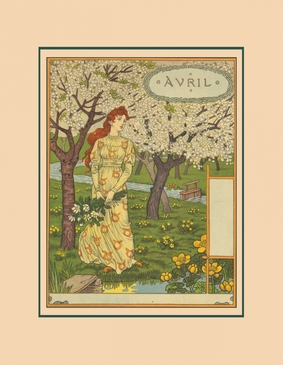
Public Domain
March is over and April has come around again, as it always does, with perhaps a promise of spring. This column is being first published on April 1, 2017, and you might do well to bear that in mind as you take a look at today's checker problem.
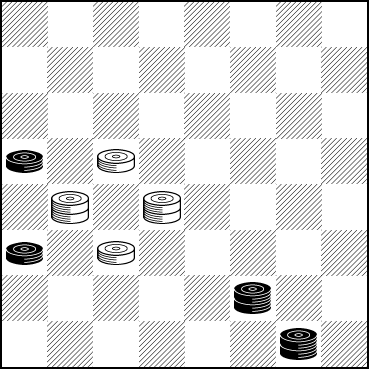
WHITE
White to Play and Win
W:W22,K18,K17,14:BK32,K27,21,13.
We rate this one as very easy. You can solve it in seconds if you get the idea. But it's almost surely impossible if you don't see what's going on.
Are you sharp today? Don't fool around; puzzle it out and then click your mouse on Read More to see the solution.![]()
A Picture is Worth A Thousand Words
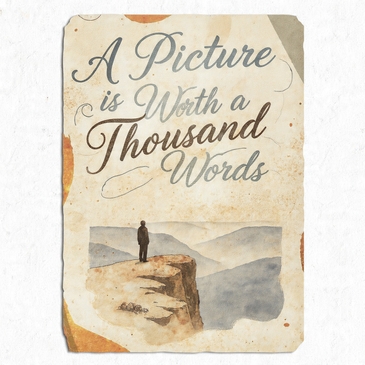
In a recent article we asked you about your preferences in board diagrams, and although there were various opinions, a clear (and nearly overwhelming) majority seem to prefer black and white diagrams with the corresponding side notations of "Black" and "White." So, as of today, we're switching over. A good picture is indeed worth a thousand words.
The problem is that we didn't think the black and white diagrams were of especially high quality. But we're happy to say that we've found a way to "port" the excellent black and white diagrams used in our print publications over to the web. We'll spare you the technical details, which involve rather arcane Linux knowledge, and instead hope that you like our new, larger, clearer diagrams. Do write and let us know what you think.
So, let's start off with a fine problem from Samuel Gonotsky. This one is taken from over the board play and it's quite a nice early endgame study.
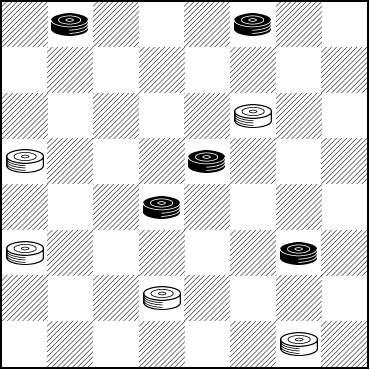
WHITE
White to Play and Draw
W:W11,13,21,26,32:B1,3,15,18,24.
Against best play by Black, White will have to work pretty hard to get the draw. Situations such as these are seldom pure black and white. Can you find your way through? Our computer found a neat move to make things much harder than we think Mr. Gonotsky intended, but that's the black and the white of it. Give it a try and then click on Read More to see the solution.![]()
The Checker Maven is produced at editorial offices in Honolulu, Hawai`i, as a completely non-commercial public service from which no income is obtained or sought. Original material is Copyright © 2004-2025 Avi Gobbler Publishing. Other material is public domain, AI generated, as attributed, or licensed under CC1, CC2,CC3 or CC4. Information presented on this site is offered as-is, at no cost, and bears no express or implied warranty as to accuracy or usability. You agree that you use such information entirely at your own risk. No liabilities of any kind under any legal theory whatsoever are accepted. The Checker Maven is dedicated to the memory of Mr. Bob Newell, Sr.

